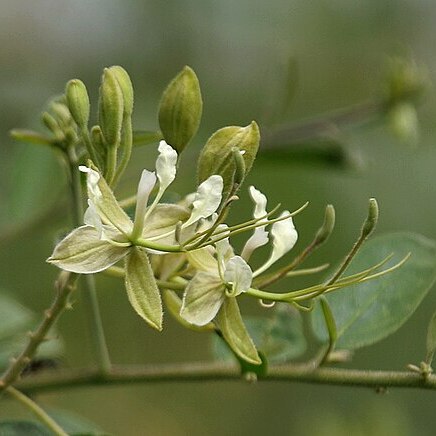Shrubs, often glandular-pubescent (or with scales), occasionally with stipular thorns. Leaves simple (or 3-merous, or wanting). Racemes terminal (or flowers solitary, axillary). Sepals 4, in 2 whorls, unequal, caducous, outer pair enveloping the bud, valvate, inner pair apert. Petals mostly 4 and equal, unguiculate. Receptacle with an adaxial, cylindrical gland. Stamens 4-8, their base connate with the gynophore (androgynophore); anthers comparatively large. Ovary on a long gynophore, 1-celled; placentas 2-4; ovules ∞, 2-seriate; stigma sessile, indistinct. Fruit mostly cylindrical, dehiscent with 2 coriaceous valves (or an indehiscent berry). Seeds ∞, subglobose, with a cartilaginous, sculptured testa; cotyledons incumbent-convolute; radicle conical.
Shrubs, often glandular-pubescent. Leaves simple or trifoliolate or absent; stipular spines sometimes present. Inflorescence a terminal raceme or flowers solitary, axillary. Sepals 4 in 2 whorls, unequal, the outer pair valvate, inner pair not meeting, caducous. Petals mostly 4, equal, clawed. Stamens 4–8, connate with each other at base and adnate to gynophore to form androgynophore. Receptacle protrusion a cylindrical, adaxial gland. Gynophore long; ovary unilocular with 2–4 placentas. Fruit cylindrical, dehiscent with 2 coriaceous valves or and indehiscent berry. Seeds subglobose to reniform, sculptured.
Disk large and conspicuous forming a nectary adherent to the base of the androgynophore, urceolate or infundibuliform or tubular, sometimes with a recurved neck, sometimes dentate at the mouth.
Ovary on an elongated gynophore, 1-locular with 2–(4) placentas, multiovulate; stigma sessile, capitate or forming an apiculus on the ovary.
Seeds subglobose or subreniform; testa ridged or smooth, often embedded in a bright orange or scarlet, floury matrix.
Sepals 4, sub-equal or unequal in 2 series, the upper and lower valvate and enclosing the lateral sepals.
Flowers somewhat zygomorphic, solitary or fascicled in the leaf-axils or in terminal, leafless racemes.
Fruit cylindric, indehiscent or tardily dehiscent by 2 valves, glabrous or glandular, many-seeded.
Leaves usually entire, occasionally rudimentary or absent.
Shrubs, unarmed or the branches becoming spine-tipped.
Androgynophore elongated and often declinate.
Petals 2–4 or 0, clawed.
Stamens 4–8.

